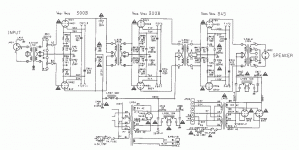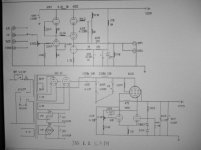Hi All
Ma good friend is using a tube preamp that uses a 2A3 for the rectifier. He would like to convert it to a silicon diode rectifier. Any ideas or does anyone have a drawing of how to do it?
Thanks
r
Ma good friend is using a tube preamp that uses a 2A3 for the rectifier. He would like to convert it to a silicon diode rectifier. Any ideas or does anyone have a drawing of how to do it?
Thanks
r
Same as western electric did with the 211? ... see here
Western Electric - Rosetta Stone for Triodes
about 3/4 of the way down the page ... don't think I'll get away with one of these in the lounge 😉
Western Electric - Rosetta Stone for Triodes
about 3/4 of the way down the page ... don't think I'll get away with one of these in the lounge 😉
Hi All
Ma good friend is using a tube preamp that uses a 2A3 for the rectifier. He would like to convert it to a silicon diode rectifier. Any ideas or does anyone have a drawing of how to do it?
Thanks
r
Or it could in fact be an 80 or similar, I had what was obviously an 80 handed to me as a "black plate 2A3" at a show once and had a real job to convince the individual doing so that it was in fact not a 2A3..
i would want to learn how your friend manage to use 2a3 as a rectifier.
As you do with any triode: connect its grid to the cathode (if it is an indirectly heated tube) or to the ground, where the filament will be referenced as well (if it is a directly heated tube) and you get a diode out of it.
@robmil: what seems to be the problem ? Remove the tube, replace it with a series connection of power resistor (to obtain same voltage drop) and a silicon rectifier diode and you're done.
Last edited:
Technically you'll get a diode that way, but in all my years the proper way has been to connect the grid to the plate as pictured in the Western Electric schematic posted by Doz. Not to the cathode.As you do with any triode: connect its grid to the cathode (if it is an indirectly heated tube) or to the ground, where the filament will be referenced as well (if it is a directly heated tube) and you get a diode out of it.
But this will result in grid dissipation, and could lead to a meltdown and fireworks should remains of the grid make physical connection to cathode 😕
But this will result in grid dissipation, and could lead to a meltdown and fireworks should remains of the grid make physical connection to cathode 😕
The grid surface area is very small compared to the plate area and almost all of the electrons will miss the grid and proceed directly to the plate. It works fine in any application I have tried, particularly with low mu triodes which have grids with wide spacings.
Your proposed connection may theoretically be worse under high current conditions if the grid actually gets warm enough and starts to emit electrons on its own. In any event its not recommended in any tube design manual I have seen.
I have a tube compressor that has the grid of an ECC82 coupled to it's plate to rectify the audio and that fed to the screen of an EF86 in the input stage to make it compress... works rather well.
Perhaps I'm showing my ignorance here, but what exactly is the point in using a 2A3 as a rectifier? I'm not trying to sound pompous here, mind you. There may very well be a legitimate reason to do so (a potentially lower voltage drop leaps to mind), and I'm hoping someone here could enlighten me...
Perhaps I'm showing my ignorance here, but what exactly is the point in using a 2A3 as a rectifier? I'm not trying to sound pompous here, mind you. There may very well be a legitimate reason to do so (a potentially lower voltage drop leaps to mind), and I'm hoping someone here could enlighten me...
I don't think there is ... it's just that it is possible....
🙄
This doesn't really apply to todays world, but years ago manufactures would sometimes use triodes as rectifiers because they were available as surplus in quantity and probably very cheap. One that comes to mind is my old Heathkit C-3 condenser checker. It uses a 1626 as a half wave rectifier in a doubler. I built it from a kit a looooong time ago. It still works perfect and every so often I bring it out, power it up and use it. Yes, it has sentimental value so I keep it going even though I have better instruments that do the same thing. Personally I would never commit a valuable and coveted 2A3 to lowly rectifier service. Well, maybe a 300B 😱 😀
Thanks guys for the replies. I'm going to get the schematic for this so you can have a look. I still don't understand how you can configure a Triode for rectifier duties. Any rough drawing would be appreciated.
R
R
Thanks guys for the replies. I'm going to get the schematic for this so you can have a look. I still don't understand how you can configure a Triode for rectifier duties. Any rough drawing would be appreciated.
R
Just tie plate and grid together and voila - you have a rectifier..
Perhaps I'm showing my ignorance here, but what exactly is the point in using a 2A3 as a rectifier? I'm not trying to sound pompous here, mind you. There may very well be a legitimate reason to do so (a potentially lower voltage drop leaps to mind), and I'm hoping someone here could enlighten me...
Marketing; WOW, - a 2A3 PreAmp !!!
MingDa has one...(and a RIAA that use 6N6P as rectifier)
Arne K
Attachments
Good grief! There's no way I'd buy that amp, as mere 2A3's aren't good enough. Only 300B rectifiers for me! 😉
That one's kind of reminiscent of the "Unnecessarily Complex 300B Amp", except that Pete Millett's design - while certainly a bit extravagant - actually made good sense...
That one's kind of reminiscent of the "Unnecessarily Complex 300B Amp", except that Pete Millett's design - while certainly a bit extravagant - actually made good sense...
- Status
- Not open for further replies.
- Home
- Amplifiers
- Tubes / Valves
- 2A3 rectifier

